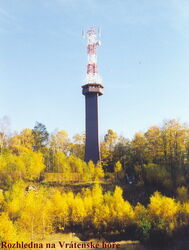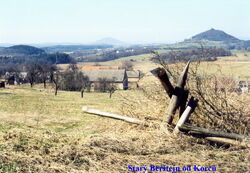So as to get closer to the highest hill of the Kokořínsko (Kokořín region), we have to take the local train running through Mšeno. We need to get off at Skramouš, which is where the blue footpath began (today begins in Mšeno), leading through the village and Bízova rokle (ravine) all the way to Lobeč. The footpath does not lead through the center - should you be interested in seeing the Baroque chateau and the parish church standing on the hilltop, you have to leave the path and take the road climbing up the hill. Lobeč is both the birthplace and place where Eduard Štorch is laid to rest - one of his prehistoric novels, Minehava, takes place in the surroundings of this village.
 The footpath then climbs up through the woods to Nosálov, going past the village with its one of the best-preserved rural architectures in the whole region – should you want to have a look at its timbered houses with porches and some Empire style gates, standing in the shade of 200 year-old lime trees, you have to get off the path where it intersects with the village road. This will make the trip some 2 kilometers longer; however, it is worth taking as you can visit the local pub, exalted by tourists. You will soon burn the energy acquired from the food intake while climbing the highest hill of the Kokořín region, Vrátenská Mountain, standing 508 meters above sea level. Not far from its peak you can find a recently erected lookout tower – it replaced the old one, a former old fire tower which was moved here from Mšeno in 1893 and which collapsed shortly after in 1903 due to poor maintenance. The new, 42 meters high tower offers vistas from the roofed observation deck 24 meters above ground. Having climbed 126 steps, you will get a view over the whole Mácha region as well as over the neighboring Český ráj (Bohemian Paradise) with the ranges of Krkonoše and Jizerské mountains in the background.
The footpath then climbs up through the woods to Nosálov, going past the village with its one of the best-preserved rural architectures in the whole region – should you want to have a look at its timbered houses with porches and some Empire style gates, standing in the shade of 200 year-old lime trees, you have to get off the path where it intersects with the village road. This will make the trip some 2 kilometers longer; however, it is worth taking as you can visit the local pub, exalted by tourists. You will soon burn the energy acquired from the food intake while climbing the highest hill of the Kokořín region, Vrátenská Mountain, standing 508 meters above sea level. Not far from its peak you can find a recently erected lookout tower – it replaced the old one, a former old fire tower which was moved here from Mšeno in 1893 and which collapsed shortly after in 1903 due to poor maintenance. The new, 42 meters high tower offers vistas from the roofed observation deck 24 meters above ground. Having climbed 126 steps, you will get a view over the whole Mácha region as well as over the neighboring Český ráj (Bohemian Paradise) with the ranges of Krkonoše and Jizerské mountains in the background.
From here you will follow the blue footpath leading by the secluded dwelling at Na Fučíkovském till you get to Houska. The chateau has been made accessible to public again after many years, even with the renovation works still under way. A Gothic chapel with rare frescos is to be seen here, a toilet where only a thin board separated our ancestors from falling into the depths, or the castle well, whose water was just recently flavored with acid seeping in here from the several tens of kilometers distant uranium mines in Ralsko. Following the tour we will take the red footpath, heading for Zámecký vrch with a vista and church remains and from there on we will follow the blue footpath. By Dolní Houska we will have lost elevation which means we have to do uphill again, from Týnský valley to Smrkový hřeben (Spruce crest). Let’s cross the road to Bořejov and we will come to the top of Velký Beškov by way of Kočičí hřeben (Cat crest) – don’t expect any views here, as the lofty beeches, peculiar to the local mixed forests, hinder the view.
 The rest of the trip is downhill, above Panská ves you can feast your eyes on the view over Dubá and Starý Bernštejn, below which rises the Liběchovka stream, into whose valley we can get by following the blue footpath. We go by a narrow pass on our left, through which the stream flows to Rozprechtice. In Nedamov we can have a nice swim in the Černý Rybník (Black pond) and ahead of us we have the last of today’s 21 kilometers – till we come to the bus station in Dubá, where we can get on lines running to Mělník or Prague.
The rest of the trip is downhill, above Panská ves you can feast your eyes on the view over Dubá and Starý Bernštejn, below which rises the Liběchovka stream, into whose valley we can get by following the blue footpath. We go by a narrow pass on our left, through which the stream flows to Rozprechtice. In Nedamov we can have a nice swim in the Černý Rybník (Black pond) and ahead of us we have the last of today’s 21 kilometers – till we come to the bus station in Dubá, where we can get on lines running to Mělník or Prague.
